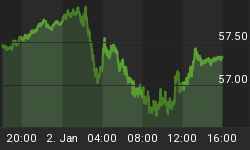The Dow Industrials fell sharply again, down 185.58 points to close at 13,360.26 Friday. Volume was huge on the decline in all major averages, which is not good. NYSE volume was 134 percent of its 10 day average, with downside volume leading at 78 percent, with declining issues at 74 percent, with S&P 500 downside points leading at a near panic 89 percent. NYSE New 52 week Highs came in at 88, with New Lows at 73, and for all intents and purposes, we got a third Hindenburg Omen Friday.

As of June 22nd, 2007, we have a confirmed Hindenburg Omen signal on the clock. Our first Hindenburg Omen observation occurred on June 13th, 2007. Confirming signals occurred for all intents and purposes on June 21st, and June 22nd, giving us a three observation cluster.
So what is a Hindenburg Omen? It is the alignment of several technical factors that measure the underlying condition of the stock market -- specifically the NYSE -- such that the probability that a stock market crash occurs is higher than normal, and the probability of a severe decline is quite high. This Omen has appeared before all of the stock market crashes, or panic events, of the past 22 years. All of them. No panic sell-off occurred over the past 22 years without the presence of a Hindenburg Omen. Another way of looking at it is, without a confirmed Hindenburg Omen, we are pretty safe. But we have one as of June 22nd, 2007. The way Peter Eliades put it in his Daily Update, September 21, 2005 (Peter is well worth the read, believe me), "The rationale behind the indicator is that, under normal conditions, either a substantial number of stocks establish new annual highs or a large number set new lows -- but not both." When both new highs and new lows are large, "it indicates the market is undergoing a period of extreme divergence -- many stocks establishing new highs and many setting new lows as well. Such divergence is not usually conducive to future rising prices. A healthy market requires some semblance of internal uniformity, and it doesn't matter what direction that uniformity takes. Many new highs and very few lows is obviously bullish, but so is a great many new lows accompanied by few or no new highs. This is the condition that leads to important market bottoms."
Our research notes that plunges can occur as soon as the next day, or as far into the future as four months. In either case, the warning is useful. It just means, if you want to play the short side after a confirmed signal, or move out of harms way, you must be prepared to see it happen as soon as the next day, or four months from now, possibly after you forgot about it. About half occurred within 41 days.
Oftentimes equities will rally after a Hindenburg Omen occurs, faking folks out, then the plunge comes on the other side of the hilltop. 1987 is a perfect example of that, as was 2006.
So far as June 22nd, 2007, here are the details of the three Hindenburg Omen observations:
June 13th, 2007: There were 3,428 NYSE issues traded, with 96 New Highs and 95 New Lows, the common number equal to 2.77 percent of total issues traded, above the minimum requirement of 2.20 percent. The McClellan Oscillator was negative -116.92. The NYSE 10 week moving average was rising.
June 21st, 2007: There were 3,434 NYSE issues traded, with 106 New Highs and 75 New Lows, the lesser number equal to 2.18 percent of total issues traded, essentially 2.20 percent. The McClellan Oscillator was negative -36.65. The NYSE 10 week moving average was rising.
June 22nd, 2007: There were 3,422 NYSE issues traded, with 88 New Highs and 73 New Lows, the lesser number equal to 2.13 percent of total issues traded, essentially 2.20 percent. The McClellan Oscillator was negative -116.59. The NYSE 10 week moving average was rising.
What does it mean for traders and investors when we get a confirmed Hindenburg Omen? This is really important to understand. A confirmed Hindenburg Omen is not a guarantee of a stock market crash. The odds of a crash after getting a confirmed Hindenburg Omen, based upon the history since 1985, is 25.0 percent. That means the odds we will not have a crash are quite high, at 75.0 percent. It simply means there is a far greater than normal risk of a significant decline occurring within four months of the signal.
You now also have to factor that the Fed is pumping liquidity to prevent crashes once these signals occur. So you do not want to go short the farm.
We cover the Hindenburg Omen in more detail, including the probabilities of various levels of decline, for our subscribers at www.technicalindicatorindex.com.
"Even so consider yourselves to be dead to sin,
But alive to God in Christ Jesus."
Romans 6: 11
Our July 4th Special! Two Years for $359, and we'll mail you the book, "Elliott Wave Principle" for FREE.
Simply go to www.technicalindicatorindex.com and click on the Subscribe Today button. Once you have subscribed, send us an email to let us know your shipping address to receive the FREE book. The Book only comes with the two year renewal option.
















